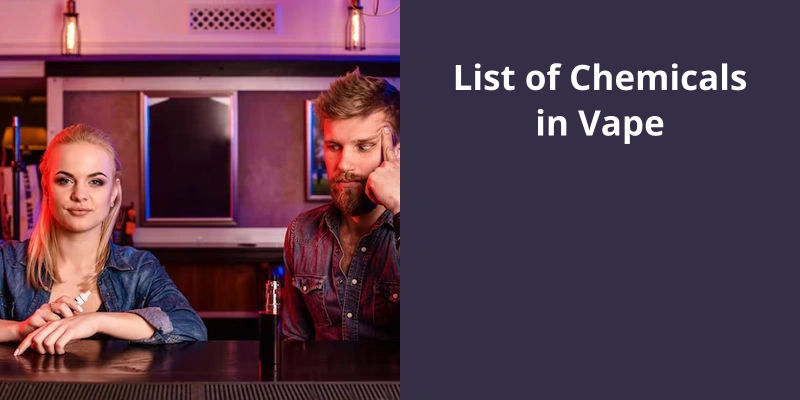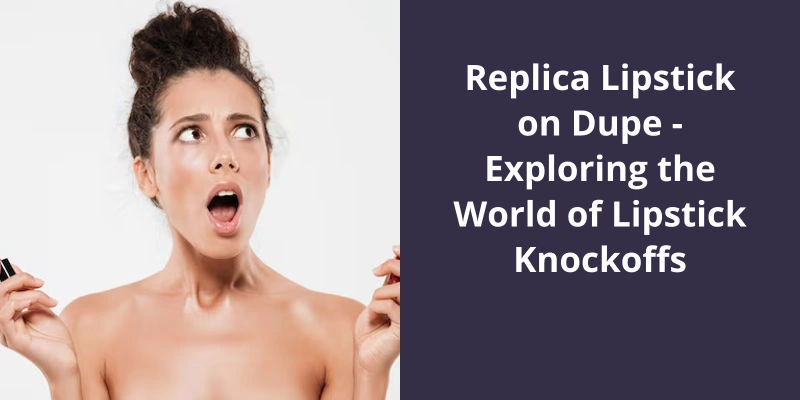Vape, also known as e-cigarette, contains several chemicals. The most commonly known ingredient is nicotine, a highly addictive substance. It also contains propylene glycol and vegetable glycerin, which are used to create the visible vapor. Flavorings in vapes also contain a variety of chemicals, many of which are not safe for inhalation like diacetyl, a flavoring agent linked to lung disease. Formaldehyde and acrolein, harmful toxins harmful to the respiratory system, are also found in vape. These chemicals, among many others, show that vaping is not as harmless as it is perpetrated to be.

How Many Harmful Chemicals Are in a Vape?
Vaping has become a widespread trend among the younger population, with it’s appeal lying in the belief that it’s a safer alternative to traditional smoking. However, recent research conducted by experts at Johns Hopkins University reveals a darker side to vaping. This study shed light on the fact that vaping exposes users to a staggering amount of chemicals, approximately 2,000 to be exact. These chemicals not only include familiar substances found in e-liquids, such as nicotine, but also potentially harmful industrial compounds.
The researchers focused their study on four popular vape brands, aiming to determine the true extent of the chemical composition in each one. The results were alarming, to say the least. Numerous harmful substances were detected, including formaldehyde, acrolein, and diacetyl. These chemicals are known to have detrimental effects on the human body, ranging from respiratory issues to lung damage. Moreover, the presence of potentially harmful industrial compounds is particularly concerning as their long-term effects remain largely unexplored.
The elevated number of chemicals found in vapes raises serious health concerns for users. One of the key issues associated with inhalation of these substances is the potential for lung inflammation and an increased risk of developing chronic respiratory diseases. In addition, the presence of formaldehyde and other toxic compounds poses a significant threat to cardiovascular health. The negative impact of vaping on overall well-being can’t be underestimated.
Vaping, once thought to be a safer alternative to smoking, now raises concerns about the presence of toxic metals in vape aerosol. Recent studies have shown that certain vape products may contain harmful chemicals such as chromium, formaldehyde, lead, and nickel, which are also found in cigarette smoke. This revelation raises questions about the safety of all vapes, and whether they pose similar health risks as traditional cigarettes.
Do All Vapes Contain Toxic Metals?
Do all Vapes contain toxic metals? This is a question that’s gained significant attention in recent years as the popularity of vaping has continued to soar. While cigarettes are widely regarded as the deadliest form of tobacco, it’s important to note that no tobacco product is entirely safe. Vape aerosol, for instance, has been found to contain some of the same chemicals found in cigarette smoke, including chromium, formaldehyde, lead, and nickel.
These metals can have serious health implications when inhaled, with long-term exposure potentially leading to respiratory issues, cardiovascular problems, and even neurological disorders.
This metal is known to be carcinogenic and can increase the risk of developing various forms of cancer. Additionally, formaldehyde, which is often included in vape aerosol as a byproduct of heating the liquid, is a highly toxic substance known to cause severe respiratory problems.
It’s worth noting that the exact levels of these toxic metals can vary depending on various factors, including the type of device used and the specific e-liquid being vaped. However, it’s clear that the potential for exposure to these harmful substances exists, and users should be aware of the potential risks associated with vaping.
While vapes may be considered a safer alternative to traditional cigarettes, they aren’t without their own set of health risks. As with any tobacco product, it’s important to be informed and make educated decisions about ones own health.
Watch this video on YouTube:
When it comes to vaping, safety is a top priority for many users. In order to ensure a clean and toxin-free experience, it’s important to choose vape brands that prioritize transparent labeling and use only the safest ingredients. Pure Eliquids boldly leads the way in this regard, earning a reputation for their commitment to transparency. Similarly, Vapemate is recognized for their stringent safety measures and organic 100% ECOvape VSAVI delivers a worry-free vaping experience. PrimeVapor and Cloudride, too, rank among the top five safest vape brands, further solidifying their commitment to consumer safety.
What Vapes Have No Toxic Chemicals?
When it comes to vaping, safety should always be a top priority. Many people are concerned about the potential harm that chemicals found in vape products can have on their health.
Pure Eliquids is a well-known and highly respected vape brand that takes pride in their commitment to transparent labeling of all ingredients. They provide clear and detailed information about the chemicals used in their e-liquids, allowing consumers to make informed decisions about what they’re putting into their bodies.
Vapemate is another brand that’s recognized for their dedication to safety. They go above and beyond to ensure that their products are free from harmful chemicals, and they even conduct regular third-party testing to confirm the purity of their e-liquids.
For those looking for an organic and eco-friendly option, 100% ECOvape VSAVI is a great choice. They use only organic ingredients in their e-liquids and follow strict quality control measures to ensure their products are safe and pure.
PrimeVapor is a brand that takes safety seriously. They’ve an extensive testing process in place to ensure that their e-liquids are free from any harmful chemicals, and they’re committed to providing a safe and enjoyable vaping experience for their customers.
Cloudride is another brand that prioritizes safety. Their commitment to safety and quality has earned them a loyal following of satisfied customers.
These brands, such as Pure Eliquids, Vapemate, 100% ECOvape VSAVI, PrimeVapor, and Cloudride, are trusted by vapers who want to enjoy their vaping experience without compromising their health.
Source: Is there a vape juice with no harmful chemicals?..
Additionally, electronic cigarettes can also contain other chemicals such as formaldehyde, acrolein, and benzene, which are byproducts of the heating and vaporization process [15-17]. It’s important to be aware of the various chemicals present in vape products and their potential health risks.
What Are 5 Chemicals Found in Vape?
Electronic cigarettes, commonly referred to as vapes, typically contain a variety of chemicals. One of the main ingredients found in vapes is propylene glycol. This chemical is often used as a food additive and is generally considered safe for ingestion. However, it’s safety when inhaled as a vapor is still a topic of debate among scientists and health professionals. Another common ingredient in vapes is glycerol, which is often used as a sweetener and is generally regarded as safe for ingestion.
Ethylene glycol and polyethylene glycol are also found in some vape products. These chemicals are often used in antifreeze solutions and other industrial applications. Ingesting or inhaling high amounts of these substances can be extremely harmful, as they can cause damage to the kidneys, liver, and other organs. It’s important to note that the concentrations of these chemicals in vape products are typically much lower than those found in industrial applications.
In addition to these chemicals, vape liquids also often include concentrated flavors. These flavors can range from fruity and sweet to tobacco or menthol-like. The flavorings used in vape products are typically made up of a combination of natural and artificial ingredients. Some studies have suggested that certain flavoring compounds, when heated and inhaled, can produce harmful byproducts. However, more research is needed to fully understand the potential health risks associated with these flavorings.
Lastly, nicotine is often added to vape liquids, though it isn’t present in all products. Nicotine is a highly addictive substance that’s naturally found in tobacco plants. It’s presence in vape products can make them more appealing to smokers looking to quit traditional cigarettes. However, it’s important to note that nicotine is a toxic chemical and can have detrimental effects on the cardiovascular system, among other health concerns.
It’s important for individuals to be aware of the potential risks associated with vaping and to make informed decisions about their own health.
Dangers and Health Risks Associated With Vaping
Vaping refers to the act of inhaling and exhaling vapor produced by an electronic cigarette or other similar devices. While it’s often promoted as a safer alternative to traditional smoking, it’s important to understand that vaping still carries it’s own set of dangers and health risks.
One of the primary concerns surrounding vaping is the potential harm caused by the chemicals present in e-cigarette liquids. These liquids, also known as e-juices or vape juices, typically contain a combination of nicotine, flavorings, additives, and sometimes THC or CBD. When heated, these chemicals can produce harmful substances.
Studies have shown that vaping can have various adverse effects on respiratory and cardiovascular health. The inhalation of chemicals in vape aerosols can irritate the lungs and airways, leading to lung inflammation and potential long-term lung damage. It can also cause symptoms such as coughing, wheezing, and shortness of breath. Additionally, some cases of severe lung injury have been associated with vaping.
Furthermore, the nicotine present in many e-cigarette liquids is highly addictive and can have detrimental effects on the developing brains of adolescents and young adults. It can harm memory, concentration, and impulse control. Pregnant women who vape also expose their unborn babies to nicotine, which can have negative effects on fetal development.
While more research is needed to fully understand the long-term health effects of vaping, it’s clear that vaping isn’t without risks. It’s important for individuals, especially young people and non-smokers, to be aware of the potential dangers associated with vaping and make informed decisions regarding their health.
Conclusion
Common components such as nicotine, propylene glycol, vegetable glycerin, and flavorings require careful consideration due to their potential impacts on respiratory health. Additionally, the presence of harmful substances like formaldehyde, acrolein, and heavy metals in some vape liquids underscores the importance of quality control and regulation in the industry.





